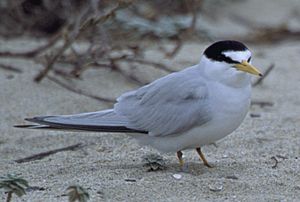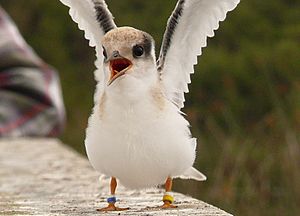California least tern facts for kids
Quick facts for kids Sternula antillarum browni |
|
|---|---|
 |
|
| Conservation status | |
| Scientific classification |
|
| Kingdom: | Animalia |
| Phylum: | Chordata |
| Class: | Aves |
| Order: | Charadriiformes |
| Family: | Laridae |
| Genus: | Sternula |
| Species: | |
| Subspecies: |
S. a. browni
|
| Trinomial name | |
| Sternula antillarum browni (Mearns 1916)
|
|
The California least tern (Sternula antillarum browni) is a small, special type of Least tern. It's a subspecies that mostly lives and raises its young in bays along the Pacific Ocean. You can find them in a small area of Southern California, like San Francisco Bay, and also in northern parts of Mexico.
These birds are migratory, meaning they travel long distances. They are considered an endangered species in the U.S., which means their population is very low and they need protection. In 1974, when people started counting them, there were only 582 breeding pairs. Thanks to protection efforts, their numbers have slowly grown. However, they are still at risk from natural disasters, predators, and human activities.
Contents
Where Do California Least Terns Nest?
We don't know exactly where California least terns spend their winters, but scientists think they might go to the Pacific Coast of South America. These birds return to their breeding grounds in California and Mexico around late April.
Before they build nests, the male and female terns perform a special courtship dance. This usually happens on open, flat areas like tidal flats or beaches, away from where they'll actually nest. Once they've chosen a mate, nesting begins in mid-May and is usually finished by mid-June.
Terns like to build their nests in open, sandy, or gravelly spots near water. In the San Francisco Bay area, they often use old, flat areas that used to be salt flats. If the ground is hard, they might use a natural dip, like a deep footprint, to make their nest. Their nesting colonies are not very crowded. They prefer quiet areas along the coast or in estuaries, away from people and predators.
Sometimes, there are only a few nests per acre. But in San Diego County, California, people have seen as many as 200 nests in one acre! A female tern usually lays two or three eggs, but sometimes it can be one or up to four. Both the mother and father tern take turns sitting on the eggs for about three weeks. Both parents also care for the young chicks. Baby terns can fly when they are about four weeks old.
After the young birds can fly, families might gather near coastal lakes. Some terns might nest later in the season, but most of the California least terns leave California by the end of August.
What Do California Least Terns Eat?
California least terns mostly hunt for food in shallow estuaries and lagoons. They also hunt in the open ocean, sometimes as far as 24 kilometers (about 15 miles) offshore, especially where there's a lot of small fish.
They fly above the water, hovering until they spot their prey. Then, they quickly dive into the water, not fully submerging, to catch the fish. In the bays and lagoons of Southern California and northern Mexico, their favorite foods include anchovies, smelt, silversides, shiner surfperch, and small crustaceans. They often feed close to shore in the ocean, especially near the mouths of lagoons or bays.
Adult terns don't need much cover, so they often rest on open ground. Once the chicks are about three days old, their parents don't sit on them as much. At this point, the chicks need protection from the wind and sun.
Sometimes, predators can cause problems for tern colonies. Burrowing owls and American kestrels are known to hunt them. Even domestic cats have been seen attacking tern colonies.
How Are They Related to Other Terns?
The California least tern is a type of Least tern (Sternula antillarum). Other least terns breed along the Atlantic Ocean coast of the United States, from Maine down to Florida and Texas. You can also find least terns breeding along rivers in the central U.S. and the Great Plains.
Both the California least tern and the other least terns are about 23 centimeters (9 inches) long. They both have clear black markings on their outer wing feathers. When they fly over water, they have a unique hunched look, with their bills pointing slightly downward.
The least tern is also very similar to the Little tern (Sternula albifrons), which lives in many parts of the Old World (Europe, Asia, Africa, Australia). The main differences between the little tern and the least tern are that the little tern has a white rump and tail (not grey), and it makes a different call.
Images for kids







